
The royal family appears to have appropriated two sets of stamps that were official state gifts, incorporating them into an extraordinarily valuable private stamp collection that King Charles inherited from his mother.
The gifts, a mint collection of historical Canadian stamps and a rare set of stamps from Laos, were formally given to the royal family as state gifts. They appear to have been subsumed into the royal philatelic collection (RPC), a private trove of rare stamps estimated to be worth at least £100m.
The private acquisitions raise further questions about whether the royal family is abiding by the letter or spirit of guidelines that prohibit official gifts from being treated as private property.
The Canadian stamps were given by the government of the Dominion of Canada in 1939 – before the policy on gifts was introduced in the mid-1990s. The rules do not state whether they should be applied retrospectively.
The framed Laos stamp set was an official gift from June 2016. A present to mark Queen Elizabeth II’s 90th birthday, it was received by the UK’s ambassador to Laos, to be sent to London and added to the RPC.
A Buckingham Palace spokesperson said: “The Royal Philatelic Collection is privately owned, and thus we would not comment on any of the issues you raise.”
The discoveries by the Guardian are likely to renew questions around high-value gifts that the royals regard as their private property.
Last week the Guardian revealed how King Charles III and Queen Elizabeth II appear to have made almost £2m from the sale of horses that were gifts from a Dubai sheikh, a Muslim religious leader and a Saudi royal. The palace indicated it regarded the horses as “personal” gifts. However, it made no such claim with respect to the Canadian and Laos stamps.

Douglas Muir, the former senior curator of philately (the study of stamps) at the Postal Museum, said the king’s private stamp collection should be transferred to the royal collection, a trove of artworks not owned by the monarch, but held in trust by him or her for the nation.
The king’s stamp collection consists of 328 albums collected by George V, and 30 more albums collected by George VI and, most recently, Queen Elizabeth II. Four philatelic experts told the Guardian it was worth at least £100m.
“In its breadth and depth, it is the biggest and the best in the world,” said Chris Harman, a former president of the Royal Philatelic Society of London, who chairs its expert committee.
The scale of the collection suggests it has met George V’s edict in a February 1908 letter to his philatelic adviser, whom he told: “I wish to have the best collection and not one of the best collections in England.”
An obsession for George V
It is unsurprising the royals have acquired an impressive stamp collection, given George V’s obsessions. His official biographer, Harold Nicolson, noted how, for 17 years, the king “did nothing at all but kill animals and stick in stamps”.

How George V and successive monarchs procured those stamps, however, is potentially contentious.
“During George V’s reign, it was said he had personally paid for every stamp,” Muir said. “Total bullshit. He bought and paid for certain stamps. But look at all the stuff given to him. Is that legally his or the monarch’s, and who is going to say?”
Such was the king’s appetite for stamps that, in 1915, the then postmaster general, Herbert Samuel, complained of the “mutilation of the standard registration sheets” – the public record of the first sheet of stamps of each kind to be printed. These were being harvested to fulfil George V’s demand for stamps from the original registration sheets.
Letters found in the Postal Museum’s archives by Muir for his book, George V and the GPO, reveal that Samuel said the mutilation “seems to me to be wholly indefensible”. The Post Office’s solution was to produce a second registration sheet from which material could be sent to the king.
Further acquisitions appear to have come from the monarch’s sense of entitlement over British colonies. While in India in 1911, where he was crowned emperor of India, George V is said to have personally taken material from Indian postal records in which he was interested.
Courtiers sent abroad gathered stamps for George V. Kenneth Rose’s biography, King George V, noted a 1920 letter from the king’s assistant private secretary, Clive Wigram, to Godfrey Thomas, the private secretary to the future Edward VIII: “The king is delighted to hear that you are endeavouring to pinch as many stamps for him as you can during your travels.”
Cost of the crown is an investigation into royal wealth and finances. The series, published ahead of the coronation of King Charles III, is seeking to overcome centuries of secrecy to better understand how the royal family is funded, the extent to which individual members have profited from their public roles, and the dubious origins of some of their wealth. The Guardian believes it is in the public interest to clarify what can legitimately be called private wealth, what belongs to the British people, and what, as so often is the case, straddles the two.
Some stamps arrived from overseas as gifts. On a tour of Canada in 1939, the country’s postmaster general presented George VI with a full mint collection of all stamps produced from 1868. A gift from the government of the Dominion of Canada, it is now in the private RPC.
The royals’ gift policy distinguishes between “official gifts”, which are generally those received in connection with a royal’s official role or during the course of a formal engagement, and “personal gifts”, received from people who members of the royal family know personally, which are not publicly declared.
It states that “all official gifts given to the sovereign from a head of state or host government automatically become part of the royal collection”, which is maintained by the Royal Collection Trust.
For royal eyes only
While the policy is silent on whether state gifts acquired before the rules were introduced should be transferred into the royal collection, one thing is in no doubt from the perspective of Buckingham Palace: the RPC is regarded as private property. For two decades it was kept at St James’s Palace, and in 2019 it was transferred to Buckingham Palace. The public have extremely limited access to it.
Philatelists have expressed displeasure at this restricted access, with one senior figure suggesting there had been a “reluctance” from the palace to hold exhibitions in the UK and abroad in recent years.
Some material was shown at the Royal Philatelic Society at the beginning of 2023; and an overseas display of a small amount of material was approved as the request came from the crown prince of Monaco.

Calls for the RPC to be given to the nation date back to at least 1937 when, after Edward VIII’s abdication the previous year, the Sunday Express reported “the suggestion that it should be bought for the nation by government grant and public subscription”. Since then, there have been sporadic questions about the merits of such a valuable stamp collection being retained “for the eyes of the royal family alone”.
“Why not just merge the royal philatelic collection with the royal collection? A lot of people have said that; me included,” said Muir. “Whether they would want it or not – that would be another perfectly acceptable solution.”
He added: “The last thing anybody wants is that it moulders away.”
That may be a risk if the Windsors are unaware of the value of the stamps in their possession.
In 2001, the stamp dealership Stanley Gibbons held an auction to sell the Kirkcudbright Penny Black first day cover from 6 May 1840 holding 10 of the world’s first adhesive stamps for general use. Colin Avery, a philatelic auctioneer, recalls how he hoped the cover would sell for £1m, but bidders hesitated when they discovered Queen Elizabeth II was a buyer.

“They just felt they didn’t want to outbid the royalty,” Avery recalled. As a result, it sold for £250,000.
It was a royal bargain, although that appears to have been lost on the monarch. When Elizabeth was later shown the Kirkcudbright cover on a visit to her stamp collection, she remarked: “I expect my grandfather bought that.” Charles Goodwyn, then the official keeper of her collection, replied: “No, you did, ma’am.”







